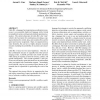Free Online Productivity Tools
i2Speak
i2Symbol
i2OCR
iTex2Img
iWeb2Print
iWeb2Shot
i2Type
iPdf2Split
iPdf2Merge
i2Bopomofo
i2Arabic
i2Style
i2Image
i2PDF
iLatex2Rtf
Sci2ools
ICSE
2000
IEEE-ACM
2000
IEEE-ACM
Little-JIL/Juliette: a process definition language and interpreter
Little-JIL, a language for programming coordination in processes is an executable, high-level language with a formal (yet graphical) syntax and rigorously defined operational seThe central abstraction in Little-JIL is the "step," which is the focal point for coordination, providing a scoping mechanism for control, data, and exception flow and for agent and resource assignment. Steps are organized into a static hierarchy, but can have a highly dynamic execution structure including the possibility of recursion and concurrency. Little-JIL is based on two main hypotheses. The first is that coordination structure is separable from other process language issues. Little-JIL provides rich control structures while relying on separate systems for resource, artifact, and agenda management. The second hypothesis is that processes are executed by agents that know how to perform their tasks but benefit from coordination support. Accordingly, each Little-JIL step has an execution agent (hu...
Coordination Structure | Dynamic Execution Structure | ICSE 2000 | SeThe Central Abstraction | Software Engineering |
| Added | 25 Aug 2010 |
| Updated | 25 Aug 2010 |
| Type | Conference |
| Year | 2000 |
| Where | ICSE |
| Authors | Aaron G. Cass, Barbara Staudt Lerner, Stanley M. Sutton Jr., Eric K. McCall, Alexander E. Wise, Leon J. Osterweil |
Comments (0)

